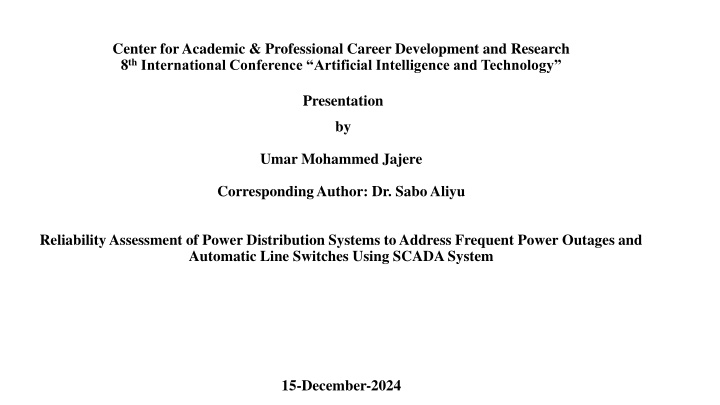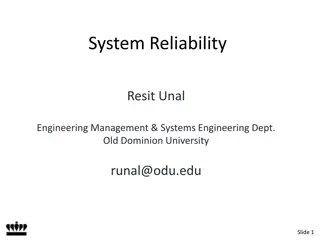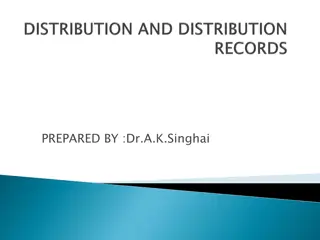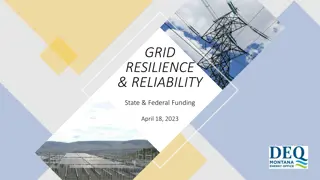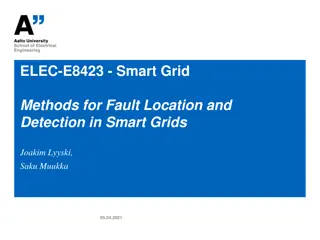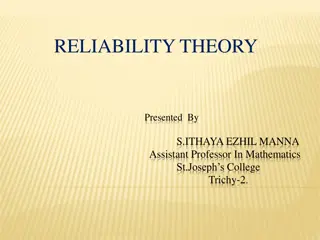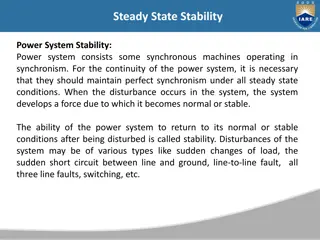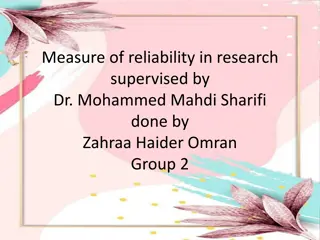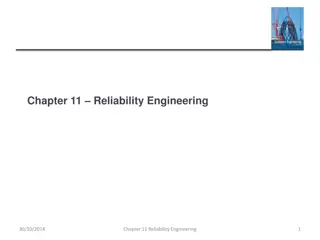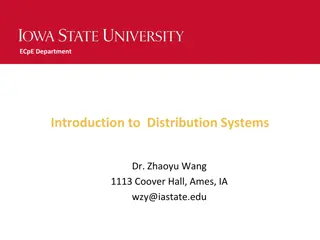Reliability Assessment of Power Distribution Systems to Improve Grid Stability
This study delves into the challenges faced by Nigeria's power sector, focusing on frequent outages and the need for smart grid technologies. It explores solutions such as infrastructure upgrades, smart technologies, and Automatic Line Switches for faster restoration. The research aims to propose practical strategies to minimize outages, enhance fault detection, and compare Nigeria's power network reliability with global benchmarks.
Download Presentation

Please find below an Image/Link to download the presentation.
The content on the website is provided AS IS for your information and personal use only. It may not be sold, licensed, or shared on other websites without obtaining consent from the author.If you encounter any issues during the download, it is possible that the publisher has removed the file from their server.
You are allowed to download the files provided on this website for personal or commercial use, subject to the condition that they are used lawfully. All files are the property of their respective owners.
The content on the website is provided AS IS for your information and personal use only. It may not be sold, licensed, or shared on other websites without obtaining consent from the author.
E N D
Presentation Transcript
Center for Academic & Professional Career Development and Research 8thInternational Conference Artificial Intelligence and Technology Presentation by Umar Mohammed Jajere Corresponding Author: Dr. Sabo Aliyu Reliability Assessment of Power Distribution Systems to Address Frequent Power Outages and Automatic Line Switches Using SCADA System 15-December-2024
Introduction Electricity is vital for economic growth, but Nigeria s Power Sector (NPS) struggles with reliability due to rapid population growth, increasing demand, and inadequate planning. Frequent outages, caused by equipment failures and human errors, highlight the need for smart grid technologies and automatic line switches to improve reliability and ensure a stable power supply.
Statement of research problem Frequent outages in power distribution systems disrupt stability, economy, and consumer convenience. Developing countries like Nigeria face challenges due to outdated infrastructure and limited investment. Solutions require: Infrastructure upgrades and better maintenance. Smart technologies (e.g., smart meters, automated controls). Automatic Line Switches (ALS) for fault isolation and faster restoration. Challenges to implementation: High costs, regulatory support, and skilled personnel. Global case studies reveal best practices for improving grid reliability and resilience.
Justification of the study Reliable electricity is essential for economic growth, social development, and technological advancement. However, Nigeria s frequent power outages hinder productivity, disrupt daily life, and exacerbate economic losses. This study is crucial to: Address critical gaps in the reliability of power distribution systems. Propose practical strategies for minimizing outages and improving grid stability. Explore the integration of smart technologies and Automatic Line Switches (ALS) to enhance fault detection, isolation, and restoration processes. Provide insights into best practices from global case studies to adapt solutions tailored to Nigeria s unique challenges.
The specific aim and objectives of the study Aim of the study The aim of this research is to assess the reliability of power distribution systems Objectives of the study are to; Examine reliability concerns in power distribution systems, including methodologies and indices such as the Markov model. Analyze factors influencing outages, evaluate mitigation strategies, and explore smart technology integration. Assess Nigeria s power network reliability and compare it with global benchmarks to identify improvement opportunities
Materials and methods This research employed an analytical approach to evaluate the reliability of power distribution systems, focusing on frequent outages, smart grid technologies, and the integration of Automatic Line Switches (ALS). Data collection involved primary sources such as field surveys, SCADA system performance reports, and reliability data from power utilities, alongside secondary sources like technical reports, academic literature, and global case studies.
Materials and Methods cont., The Markov algorithm was applied to model system reliability and predict failure probabilities, Reliability-Centered Maintenance (RCM) techniques were used to assess and improve maintenance strategies. Smart grid technologies, including smart meters and automated fault detection systems, were analyzed for their effectiveness in enhancing grid monitoring and anomaly detection.
Materials and Methods cont., Simulations were conducted to evaluate the strategic placement and configuration of ALS for fault isolation and service restoration. Comparative analysis of global case studies from utilities such as PG&E and FPL provided insights into best practices, which were adapted to Nigeria s unique power distribution challenges. Proposed solutions were validated using real-world data and simulations to measure their impact on reliability improvement, outage reduction, and operational efficiency.
Materials and Methods cont., This flowchart illustrates the sequence of operations for fault detection, verification, isolation, and restoration within a SCADA- enabled power distribution system. Let me know if you need any modifications! SCADA System Operation Flowchart
Results the reliability assessment using the Markov algorithm revealed frequent outages in Nigeria s power distribution system, primarily caused by equipment failures, outdated infrastructure, and inadequate maintenance. Smart technologies, such as smart meters and automated fault detection systems, significantly improved fault detection and response times, reducing restoration times by up to 40%.
Results cont., The deployment of Automatic Line Switches (ALS) in simulated scenarios reduced outage durations by 50% and minimized the impact of faults on connected loads. Case studies from global utilities highlighted the effectiveness of smart grid technologies and ALS in improving reliability, providing practical insights for Nigeria's power sector.
Results cont., Reliability Indices Table This table comparing reliability indices (e.g., SAIFI, SAIDI, CAIDI) before and after implementing SCADA and automatic line switches. Before After Index Improvement (%) Implementation Implementation SAIFI 2.5 interruptions/year 1.2 interruptions/year 52% SAIDI 4.5 hours/year 1.8 hours/year 60% CAIDI 1.8 hours/interruption 1.5 hours/interruption 17%
Discussion The reliability assessment of power distribution systems plays a critical role in ensuring the sustainability of modern electrical grids. This research employed a Markov algorithm in combination with SCADA (Supervisory Control and Data Acquisition) systems to evaluate and mitigate frequent power outages. The integration of these methodologies provided a framework to enhance system reliability by analyzing failure rates, repair times, and the automated switching mechanisms.
Conclusion The integration of SCADA systems and the use of Markov algorithms present a viable solution for improving the reliability of power distribution systems. While challenges such as cost and data accuracy remain, the benefits of automated fault isolation and real-time monitoring far outweigh the limitations. This study underscores the importance of advanced technologies in addressing the growing demand for reliable power systems.
Recommendations To enhance reliability, the study recommends modernizing infrastructure and adopting smart grid technologies, including smart meters and automated fault detection systems. Strategic deployment of ALS should be prioritized to isolate faults and restore service quickly. Regulatory support and increased investment are essential for grid modernization, alongside training personnel to manage advanced technologies and reliability-centered maintenance. Collaboration among utilities, policymakers, and technology providers is vital, and pilot projects should be conducted to validate the proposed strategies in real-world conditions.
References B. Adebanji, O. Atoki, T. Fasina, O. Adetan, and A. Abe, Comparative study of off-grid and grid-connected hybrid power system: issues, future prospects and policy framework, Indones. J. Electr. Eng. Comput. Sci., vol. 22, no. 2, pp. 752 759, 2021, doi: 10.11591/ijeecs.v22.i2.pp752-759. [2] A. AIROBOMAN, Reliability Assessment of Power System Network: A Detailed Review, Int. J. Eng. Technol. IJET, vol. 7, no. 4, pp. 90 103, 2022, doi: 10.19072/ijet.952933. [3] A. Shokrollahi, H. Sangrody, M. Motalleb, M. Rezaeiahari, E. Foruzan, and F. Hassanzadeh, Reliability assessment of distribution system using fuzzy logic for modelling of transformer and line uncertainties, 2017 North Am. Power Sym p. NAPS 2017, no. July, 2017, doi: 10.1109/NAPS.2017.8107257. [4] H. K. Ahmed, R. N. Tuncay, and M. H. Alkhafaji, Improving the Performance of a Realistic Distribution Network in Kirkuk by Integrating a Distributed Hybrid System, Int. J. Renew. Energy Res., vol. 13, no. 2, pp. 998 1014, 2023, doi: 10.20508/ijrer.v13i2.14037.g8771. [5] A. Akbari-Dibavar, S. Nojavan, and K. Zare, Optimal Sitting and Sizing of Energy Storage Systems in a Smart Distribution Network Considering Network Constraints and Demand Response Program, Res. Artic. J. Energy Manag. Technol., vol. 3, no. 2, p. 14, doi: 10.22109/jemt.2018.143478.1115. [6] A. M. Adua, A. L. Bukar, and D. M. Garba, DESIGN OF AN ELECTRICAL DISTRIBUTION NETWORK WITHIN DAMATURU, Int. J. Sci. Eng. Res., vol. 7, no. 2, pp. 1484 1493, 2016.
Referencescont., S. Dorji, A. A. Stonier, G. Peter, R. Kuppusamy, and Y. Teekaraman, An Extensive Critique on Smart Grid Technologies: Recent Advancements, Key Challenges, and Future Directions, Technologies, vol. 11, no. 3, pp. 1 21, 2023, doi: 10.3390/technologies11030081. [8] L. . Bentsen, N. D. Warakagoda, R. Stenbro, and P. Engelstad, Relative evaluation of probabilistic methods for spatio-temporal wind forecasting, J. Clean. Prod., vol. 434, no. August 2023, p. 139944, 2024, doi: 10.1016/j.jclepro.2023.139944. [9] C. Zhai, T. Y. jeh Chen, A. G. White, and S. D. Guikema, Power outage prediction for natural hazards using synthetic power distribution systems, Reliab. Eng. Syst. Saf., vol. 208, p. 107348, 2021, doi: 10.1016/j.ress.2020.107348. [10] E. Ghiani, F. Pilo, and G. Celli, Definition of Smart Distribution Networks. Elsevier Inc., 2018. doi: 10.1016/B978-0-12-814891-4.00001-1. [11] P. O. Ohiero and L. Effiong, Reliability Assessment of 33KV Power Distribution System -A Case Study of Calabar 33kV Distribution Network, vol. 11, no. 5, 2022, doi: 10.15662/IJAREEIE.2022.1105001. [12] T. Kovanen, V. Nuojua, and M. Lehto, Cyber threat landscape in energy sector, Proc. 13th Int. Conf. Cyber Warf. Secur. ICCWS 2018, vol. 2018-March, no. December, pp. 353 361, 2018. [13] J. Shi, L. Ma, C. Li, N. Liu, and J. Zhang, A comprehensive review of standards for distributed energy resource grid-integration and microgrid, Renew. Sustain. Energy Rev., vol. 170, no. August, p. 112957, 2022, doi: 10.1016/j.rser.2022.112957. [14] S. Manadhar, Reliability Assessment of Smart Distribution System and Analysis of Automatic Line Switches, 2013. [15] M. O. Balogun, M. O. Ahmed, A. A. Ajani, and H. Olaoye, Reliability Assessment of 33KV Feeder , ( A Case Study of Transmission Company of Nigeria , Ganmo Work Centre .), no. 1, pp. 77 83, 2019.
